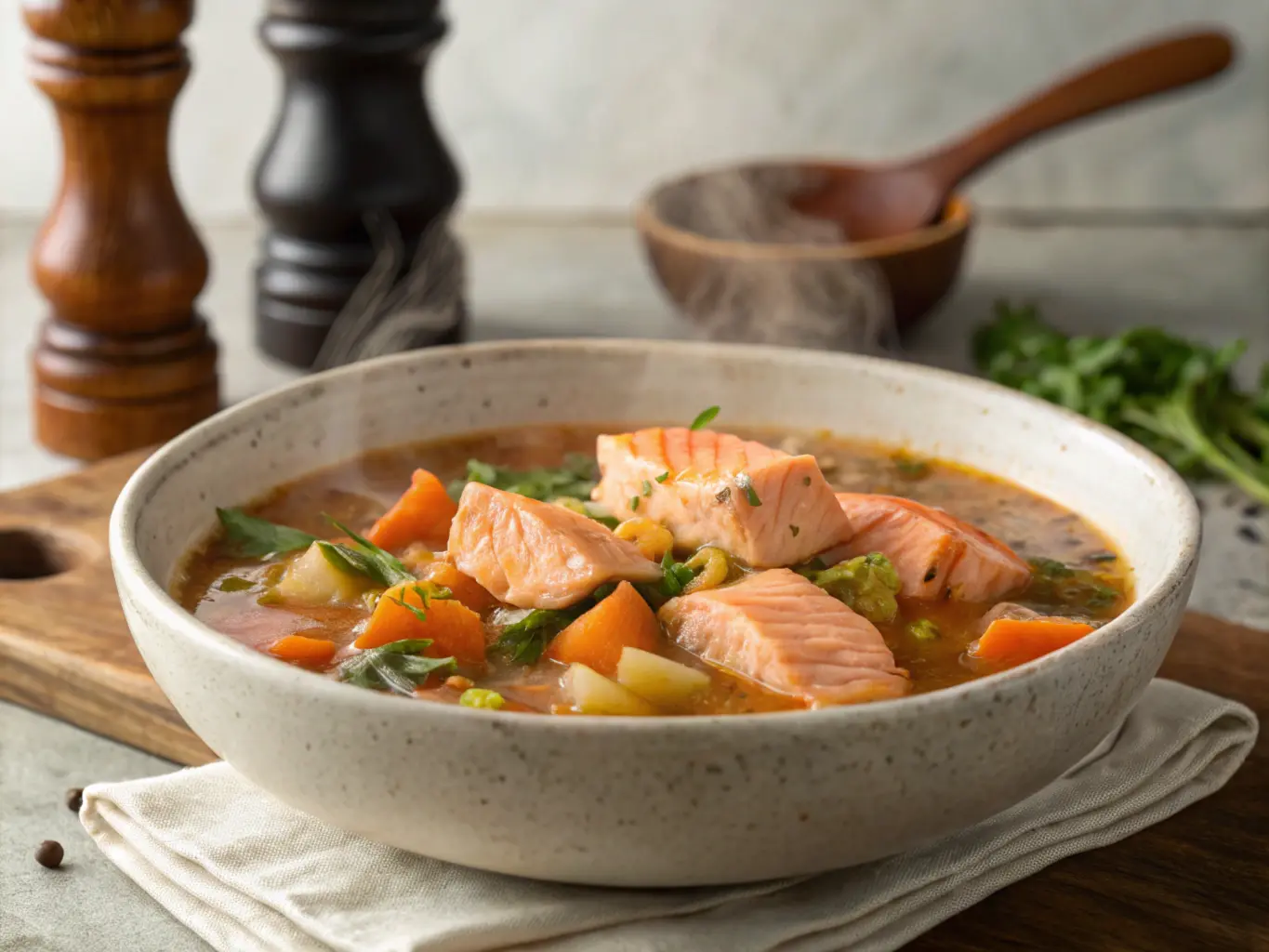
Introduction to Salmon Stew Recipe
Salmon stew is a comforting and healthy dish that combines the richness of salmon with the savory flavors of vegetables, herbs, and spices. Whether you’re cooking for a family dinner, a special gathering, or just craving something hearty, this dish is a perfect choice. Packed with Omega-3 fatty acids, vitamins, and minerals, salmon stew is not only delicious but also highly nutritious. This versatile recipe can be adjusted to suit different tastes and dietary preferences, making it a popular meal choice for many.
What is Salmon Stew?
Salmon stew is a type of soup or stew where salmon is the main protein, simmered with vegetables and broth, creating a rich, flavorful dish. Depending on the recipe, the stew may be creamy or broth-based. It is often seasoned with herbs and spices such as garlic, dill, thyme, and bay leaves, making it fragrant and aromatic. The beauty of this dish lies in its simplicity and adaptability, allowing you to customize it with different vegetables, seasonings, and liquids.
Health Benefits of Salmon Stew
Salmon is known for being a powerhouse of nutrients, particularly Omega-3 fatty acids, which play a crucial role in brain health, heart health, and inflammation reduction. In addition to healthy fats, salmon provides a good amount of protein, vitamins (like Vitamin D and B12), and minerals such as selenium. When combined with other wholesome ingredients like vegetables, salmon stew becomes a nutrient-dense meal that supports overall well-being.
Why Choose Salmon?
Salmon is often chosen for its high-quality protein, which helps with muscle repair and maintenance. It is also one of the best sources of Omega-3s, which are essential for reducing inflammation, improving heart health, and promoting cognitive function. Furthermore, salmon is a sustainable fish choice when sourced responsibly, making it an eco-friendly option for those mindful of environmental impact.
Essential Ingredients for Salmon Stew
The basic ingredients for a salmon stew recipe typically include fresh or frozen Salmon, vegetables, stock or broth, and seasonings. Here’s a closer look at the essential ingredients:
- Salmon: Fresh, skinless fillets or salmon chunks work best for this dish. You can also use frozen salmon, but be sure to thaw it properly before cooking.
- Vegetables: Common vegetables include potatoes, carrots, onions, and celery. These provide texture and flavor while balancing the richness of the salmon.
- Broth or Stock: A good quality vegetable or fish broth enhances the stew’s flavor. You can also use water, but broth adds a deeper taste.
- Herbs and Spices: Garlic, thyme, dill, bay leaves, and parsley are popular choices for seasoning. A touch of salt and pepper is essential for balance.
- Cream or Milk (Optional): For a creamy version of the stew, you can add heavy cream or a dairy-free alternative like coconut milk.
Salmon Cuts and Selection
When selecting salmon for stew, the type of cut matters. Skinless fillets are ideal because they cook quickly and evenly. You can use wild-caught or farmed salmon, but wild-caught is typically richer in nutrients. Ensure the salmon is fresh, with a firm texture and vibrant color.
Vegetables and Add-ins
The vegetables you choose will determine the texture and flavor of the stew. Potatoes add heartiness, while carrots and celery bring sweetness and crunch. Adding leafy greens like spinach or kale is a great way to boost the nutritional value. For a bit of tang, you might also consider incorporating tomatoes or lemon juice.
How to Make a Perfect Salmon Stew
Making salmon stew is relatively easy and straightforward. Follow this step-by-step guide to create a rich, flavorful dish that will impress everyone at the table.
Preparing the Salmon
Start by cutting your salmon into bite-sized pieces. If using skin-on salmon, remove the skin before cutting. You can either poach the salmon directly in the stew or sear it in a pan before adding it to the broth for added texture and flavor.
Cooking the Vegetables
In a large pot, sauté onions, garlic, and other vegetables like carrots and celery in a bit of olive oil until softened. This will enhance the flavor base of your stew. Add potatoes, and cook them for a few minutes before adding the broth.
Bringing it All Together
Once the vegetables are sautéed, add the broth and bring it to a simmer. Let it cook for about 15-20 minutes, until the vegetables are tender. Then, gently add the salmon pieces to the pot. Cook for another 5-7 minutes, allowing the fish to fully cook through. For a creamy texture, stir in some heavy cream or a non-dairy substitute. Finish with a sprinkle of fresh herbs like parsley or dill.
Variations of Salmon Stew recipe
While the classic salmon stew is delicious on its own, there are many variations that you can try, depending on your preferences.
Creamy Salmon Stew
If you enjoy a richer, creamier texture, you can add heavy cream or coconut milk to your salmon stew. This version is perfect for colder months when you’re craving something extra comforting. The creaminess balances the flavors and gives the stew a silky smooth consistency.
Spicy Salmon Stew
For those who enjoy a bit of heat, you can add chili flakes, cayenne pepper, or fresh chili to the stew. A touch of paprika or smoked paprika can also elevate the flavor with a subtle smokiness. This version pairs well with crusty bread to soak up the spiced broth.
Mediterranean-Inspired Salmon Stew
To give your stew a Mediterranean twist, add ingredients like tomatoes, olives, and capers. Fresh basil, oregano, and a drizzle of olive oil will infuse the dish with bright, vibrant flavors. This version is perfect for a lighter, more refreshing take on the classic stew.
Tips and Tricks for the Best Salmon Stew
Here are some tips to ensure your salmon stew turns out perfectly every time:
Flavor Enhancers
Don’t be afraid to experiment with different spices and herbs. A pinch of saffron or turmeric can add warmth and depth to your stew. Adding a splash of white wine or lemon juice just before serving brightens the dish and enhances the salmon’s natural flavors.
Avoiding Common Mistakes
Overcooking salmon can result in a dry, flaky texture. To avoid this, add the salmon towards the end of the cooking process and only cook until it’s opaque and easily flakes with a fork. Also, make sure to taste and adjust seasoning as you go to avoid blandness.
Pairing Sides with Salmon Stew
While salmon stew is hearty on its own, it pairs beautifully with a variety of sides.
Bread and Biscuits
Serve your stew with freshly baked bread or fluffy biscuits. The bread will soak up the flavorful broth, while the biscuits add a soft, buttery contrast to the rich stew.
Salad Pairings
A light salad with a tangy vinaigrette complements the richness of the stew. Try a simple arugula salad with lemon and olive oil or a mixed greens salad with a mustard dressing.
Storing and Reheating Salmon Stew
If you have leftovers, store them in an airtight container in the fridge for up to 2 days. To reheat, simply warm the stew over low heat on the stove, stirring occasionally. If the stew thickens too much, add a little extra broth or water to loosen it up.
Frequently Asked Questions (FAQs)
Can I use frozen salmon?
Yes, frozen salmon works perfectly in this recipe. Just make sure to thaw it thoroughly before cooking.
Can I make this stew in a slow cooker?
Absolutely! You can add the ingredients to the slow cooker and cook on low for 6-7 hours or on high for 3-4 hours. Add the salmon in the last hour to prevent overcooking.
How do I make a dairy-free version of salmon stew?
Use coconut milk or another plant-based milk as a substitute for cream. You can also opt for vegetable broth to keep it light.
Can I freeze salmon stew recipe?
Yes, salmon stew can be frozen. Make sure it has cooled completely before transferring to an airtight container. To reheat, warm it gently on the stove.
What can I substitute for potatoes in the stew?
For a low-carb alternative, you can use cauliflower or turnips instead of potatoes.
How spicy is salmon stew recipe?
The level of spiciness is entirely up to you! Adjust the amount of chili or spices based on your preferences.
Conclusion
Salmon stew is a versatile and delicious dish that offers both comfort and nutrition. Whether you enjoy it creamy, spicy, or light, this recipe can be adapted to suit any palate. With simple ingredients and a few steps, you can create a meal that is sure to impress. So, grab your ingredients and start making this wholesome dish today!
Table of Contents
Check out more Recipes Nicest
